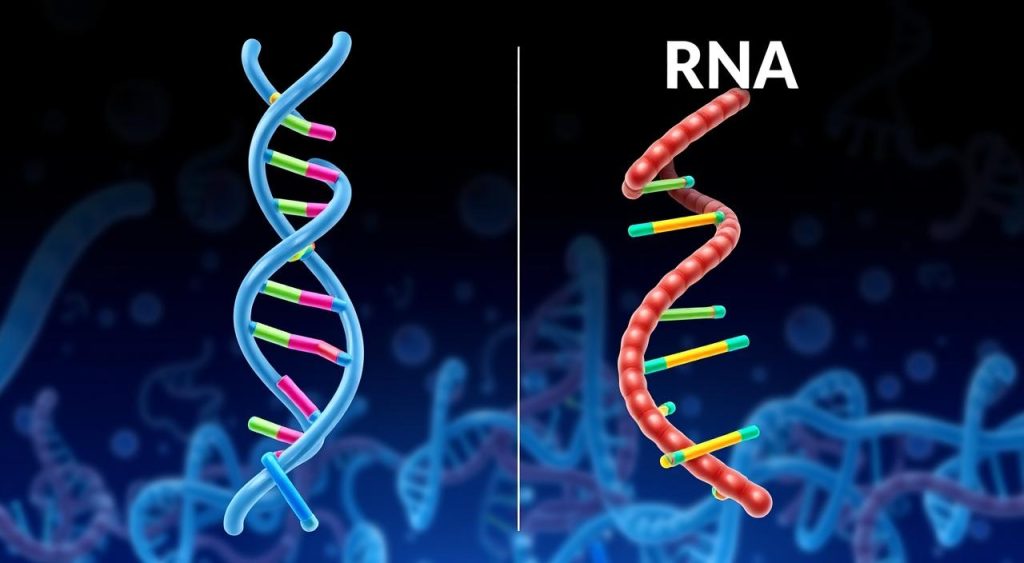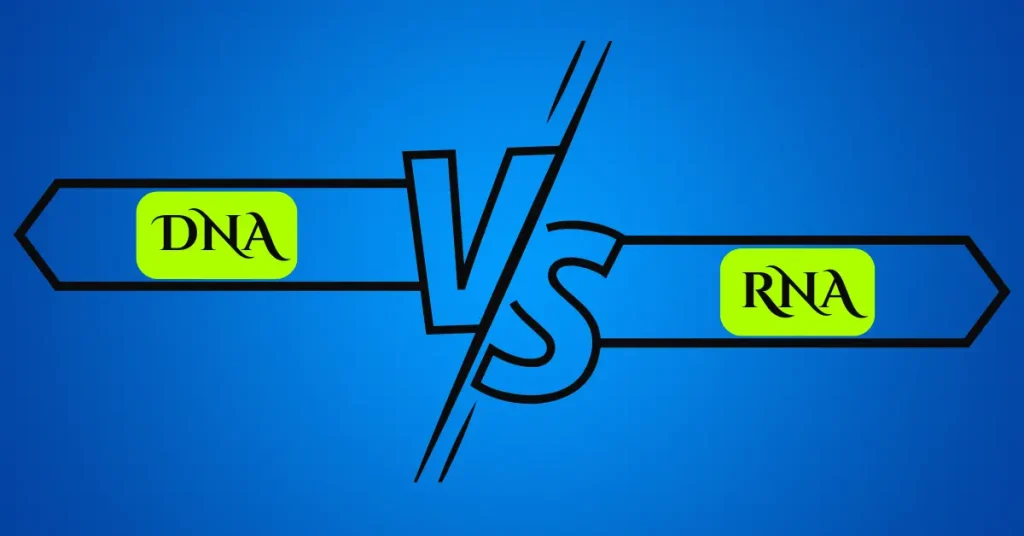When I first started learning biology, I realized that the life of every cell on earth, whether in protozoans, plants, or animals, is built on just two molecules: DNA and RNA. These nucleic acids are responsible for carrying genetic information that underpins how cells work. Both consist of sugar, phosphates, and bases, forming linear polymers that are essential for the storage and transfer of data in biology.
Yet, their roles are separate, and the distinctions between them are important. DNA is usually double-stranded, more stable, and designed to store data for the long term. At the same time, RNA is often single-stranded, more reactive, and quickly broken down by enzymes—perfect for the synthesis and transmission of protein instructions.

In my own study journey, I would often look at these molecules side by side to really understand their functions. DNA provides protection and stability, acting as the primary building block that keeps hereditary data safe, while RNA is dynamic, designed to help in function, moving information between processes, and making sure proteins are made at the right level.
Their similarities bind them together, but their differences allow them to fulfil important functions that keep life moving up the chain of complexity—from the same simple blocks to multicellular and highly complex forms. Whenever I watch a video or take a deeper look back at the structure of chromosomes, it reminds me how these strands truly stand as the key to everything we are.
Also Read: Difference Between web development and web design
What are the key differences between DNA and RNA?
In the study of biology, I often compare DNA and RNA side by side to make their differences clear. DNA carries the genetic blueprint of life, acting as a long-term storage device that preserves information across generations. It is like a flash drive that keeps data safe. RNA, however, functions as the active reader that decodes this code and helps in protein production. For example, messenger RNA (mRNA) copies parts of the code during transcription and transports them to ribosomes, the cellular factories. There, transfer RNA (tRNA) brings amino acids, the building blocks of proteins, while ribosomal RNA (rRNA) serves as a key component of the ribosome itself.
The structure also highlights these distinctions. DNA has a sugar backbone made of deoxyribose, while RNA contains ribose, which includes an extra hydroxyl group. This makes RNA more reactive but less stable. Their bases are slightly different too: DNA pairs adenine, thymine, guanine, and cytosine, while RNA uses uracil instead of thymine. The famous double helix described by Francis Crick, James Watson, and Rosalind Franklin shows the structure of DNA, whereas RNA is mainly single-stranded. From my own learning, I found it fascinating how DNA stands strong for long-term functions, while RNA works quickly to help cells perform essential tasks like translation and protein building.
DNA vs RNA – A Comparison Chart
| Aspect | DNA | RNA |
| Full Form | Deoxyribonucleic Acid | Ribonucleic Acid |
| Function | replicates, stores genetic information, serves as a blueprint for the organism | converts genetic information into format for proteins, carries it to ribosomal factories |
| Structure | Two strands, double helix, built from subunits like nucleotides, linked by phosphate, 5-carbon sugar molecule, and a nitrogenous base | One single strand, generally shorter, can form secondary double helix intermittently |
| Length | Larger polymer, part of chromosome, very long, when unraveled may extend centimeters | Variable in length, often only a few thousand bases |
| Sugar | deoxyribose, sometimes written as 2-deoxyribose, contains fewer hydroxyl groups | ribose, has extra hydroxyl group, with slight modifications |
| Bases | Adenine, Thymine, Guanine, Cytosine | Adenine, Uracil, Guanine, Cytosine |
| Base Pairs | Adenine–Thymine, Cytosine–Guanine | Adenine–Uracil, Cytosine–Guanine |
| Location | Inside nucleus, also found in mitochondria | Produced in nucleolus, travels to cytoplasm depending on type |
| Reactivity | Less reactive due to oxygen absence in deoxyribose, more stable, resists attack from enzymes, small helical grooves add protection | More unstable, reactive in alkaline medium, larger helical grooves make it prone to enzymes |
| UV Sensitivity | Ultraviolet (UV) sensitivity, can be vulnerable to light and damage | More resistant to UV damage |
| Backbone | Built from acid units, strong backbone with long-term storage ability | Built from acid units too, but acts as medium for transmission rather than long storage |
| Propagation | Naturally self-replicating, supports transmission across generations | Synthesized from DNA, not self-replicating, supports propagation only when needed |
| Additional Traits | double-stranded, long storage, essential in maintaining heredity | shorter, temporary molecule, constantly made and broken down |
| Pairing Nature | Classic pairing through nitrogenous bases | Flexible pairing, adapts to active transmission role |

Types of DNA and RNA
When we think of RNA and DNA, most people imagine the “classic” double helix or simple single strand. But scientists have discovered unusual forms of these molecules that behave in unique ways and play important roles in cells.
Z-DNA
Unlike the familiar B-DNA, which twists to the right, Z-DNA has a left-handed helix. Its backbone follows a zig-zag pattern, and it is slightly thinner. Researchers believe it helps in gene regulation and may appear when enzymes such as DNA polymerase are active.
A-DNA
A-DNA is another form that shows up when DNA is dehydrated or exposed to certain salts like K+ or Na+. It has a shorter and wider helix compared to B-DNA. This type can protect DNA from UV radiation and is often seen in spore-forming bacteria.
Triplex DNA (H-DNA)
Sometimes, DNA can form a triple helix. In this case, extra nucleotides fit into the major groove of B-DNA, creating what scientists call triplex DNA or H-DNA. These structures can encourage mutations or be used in labs with triplex-forming oligonucleotides (TFOs) to target specific genes.
C-DNA and D-DNA
Under special lab conditions, scientists also observe C-DNA and D-DNA. C-DNA appears at certain humidity levels and with lithium ions (Li+), while D-DNA is a rare variant with fewer base pairs per turn.
Double-Stranded RNA (dsRNA)
Unlike the usual single-stranded RNA, some viruses have double-stranded RNA (dsRNA). Examples include rotavirus in humans and Reoviridae in plants and animals. dsRNA is known to activate the immune system and inspired the discovery of RNA interference (RNAi), a powerful gene-silencing technology.
Main RNA Types
Cells also produce different forms of RNA:
- mRNA (messenger RNA) – carries instructions from DNA.
- tRNA (transfer RNA) – brings amino acids to ribosomes.
- rRNA (ribosomal RNA) – helps build ribosomes for protein synthesis.
- snRNA (small nuclear RNA) – assists in processing other RNAs.
Explore More: Mass vs Weight
Which Came First: DNA or RNA?
Some scientists point to evidence that RNA may have occurred first because it has a simpler structure, is needed for function, and is found in prokaryotes which precede eukaryotes. From my own study, I find it interesting that this question still brings debate, as RNA can act like a catalyst for chemical reactions and even existed before DNA evolved.
The likely answer for why DNA also existed is its double-stranded molecule, which helps protect the genetic code from damage. If one strand is broken, the other serves as a template for repair, while proteins surrounding DNA confer additional protection against enzymatic attack.
Frequently Asked Questions
What are 5 differences between DNA and RNA?
DNA is double-stranded with deoxyribose sugar and uses thymine, while RNA is single-stranded, has ribose, and uses uracil; DNA stays in the nucleus and is more stable, but RNA works in both nucleus and cytoplasm.
What is the composition of DNA and RNA?
DNA and RNA are polymers of nucleotides that seem identical, but their base pairs differ as DNA has thymine while RNA uses uracil.
Where are DNA and RNA found?
DNA is in the nucleus of a cell and in the mitochondria, while RNA is found in the cytoplasm, nucleus, and ribosomes.
What are the roles of DNA and RNA?
DNA keeps genetic information as a stable blueprint for life and the organism in the long-term, while RNA, a transient molecule, translates this DNA blueprint into proteins, carrying messages in steps from the nucleus to ribosomes in the cytoplasm.
Conclusion
The difference between DNA and RNA shows how life balances stability and action. DNA is the blueprint, storing genetic information, while RNA is the messenger, driving protein synthesis. Together, their structure, replication, and expression safeguard the genetic code that sustains every organism.



